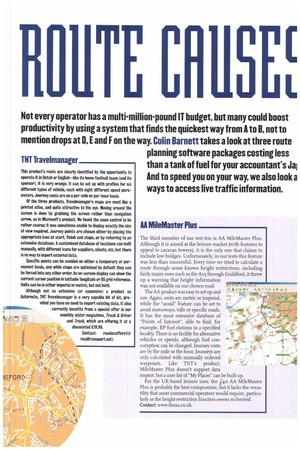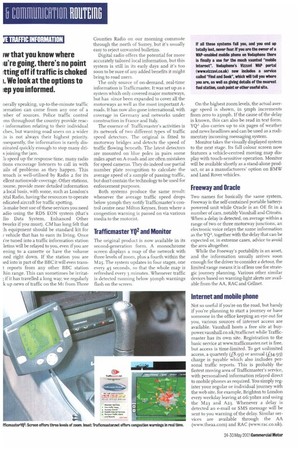UTE CR US E
Page 37

Page 38

If you've noticed an error in this article please click here to report it so we can fix it.
This product's roots are clearly identified by the opportunity to operate it in Dutch or English—like its home football team (and its sponsor). it is very orange. It can be set up with profiles for six different types of vehicle, each with eight different speed parameters. Journey costs are on a per-mile or per-hour basis.
Not every operator has a multi-million-pound IT budget, but many could boost productivity by using a system that finds the quickest way from A to B, not to mention drops at D, E and F on the way. Colin Barnett takes a look at three route planning software packages costing less than a tank of fuel for your accountant's Jal And to speed you on your way, we also look a ways to access live traffic information.
TNT Travelmanager
This product's roots are clearly identified by the opportunity to operate it in Dutch or English—like its home football team (and its sponsor). it is very orange. It can be set up with profiles for six different types of vehicle, each with eight different speed parameters. Journey costs are on a per-mile or per-hour basis.
Of the three products, Travelmanagers maps are most like a printed atlas, and quite attractive to the eye. Moving around the screen is done by grabbing the screen rather than navigation arrow, as in Microsoft's product. We found the zoom control to be rather coarse; it was sometimes unable to display exactly the size of view required. Journey points are chosen either by placing the appropriate icon at start, finish and stops, or by referring to an extensive database. A customised database of locations can built manually, with different icons for suppliers, clients, etc, but there is no way to import external data.
Specific points can be avoided on either a temporary or permanent basis, and while stops are optimised by default they can be forced into any other order. An on-screen display can show the current cursor position in latitude/longitude or OS grid reference. Units can be in either imperial or metric, but not both.
Although not as extensive (or expensive) a product as Autoroute, TNT Travelmanager is a very capable bit of kit, provided you have no need to import existing data. It also currently benefits from a special offer in our monthly sister magazines, Truck & Driver and Truck, which are offering it at a discounted £19.99.
'',!•). • Contact: reader.offers1C0 roadtransport.net).
AA MileMaster Plus
The third member of our test trio is AA MileMaster Plus. Although it is aimed at the leisure market (with features to appeal to caravan towers), it is the only one that claims to include low bridges. Unfortunately, in our tests this feature was less than successful. Every time we tried to calculate a route through some known height restrictions, including fairly major ones such as the A25 through Guildford, it threw up a warning that height information was not available on our chosen road.
The AA product was easy to set up and use. Again, units are metric or imperial, while the "avoid" feature can be set to avoid motorways, tolls or specific roads. It has the most extensive database of "Points of Interest", able to find, for example, BP fuel stations in a specified locality. There is no facility for alternative vehicles or speeds, although fuel consumption can be changed. Journey costs are by the mile or the hour. Journeys are only calculated with manually ordered waypoints. Like TNT's product, MileMaster Plus doesn't support data import, but a user list of "My Places" can be built up.
For the UK-based leisure user, the i40 AA MileMaster Plus is probably the best compromise, but it lacks the versatility that most commercial operators would require, particularly as the height-restriction function seems so limited.
flE'& !on lei Ye, Contact www.theaa.co.uk
TRAFFIC INFORMATION
pw that you know where lu're going, there's no point fling off if traffic is choked 1. We look at the options to !ep you informed.
nerally speaking, up-to-the-minute traffic armation can come from any one of a Tiber of sources. Police traffic control flis throughout the country provide reac! information relating to their individual ches, but warning road users on a wider is is not always their highest priority. nsequently, the information is rarely disninated quickly enough to stop many dris joining the jam.
7O speed up the response time, many radio tions encourage listeners to call in with ails of problems as they happen. This )roach is well-utilised by Radio 2 for its ellent nationwide coverage. Other stations, :ourse, provide more detailed information a local basis, with some, such as London's 3ital Radio, having the resources to operate edicated aircraft for traffic spotting.
Co make best use of these services you need adio using the RDS EON system (that's ilia Data System, Enhanced Other tworks if you must). CM has long felt that :h equipment should be standard kit for vehicle that has to earn its living. Once re tuned into a traffic information station letins will be relayed to you, even if you are ening to a cassette or have the volume ned right down. If the station you are Led into is part of the BBC it will even transreports from any other BBC station hin range. This can sometimes be irritat; if it has travelled a long way; we regularly k up news of traffic on the Mi from Three Counties Radio on our morning commute through the north of Surrey, but it's usually easy to reject unwanted bulletins.
Digital radio offers the potential for more accurately tailored local information, but this system is still in its early days and it's too soon to be sure of any added benefits it might bring to road users.
The only source of on-demand, real-time information is Trafficmaster. it was set up as a system which only covered major motorways, but has since been expanded to cover all the motorways as well as the most important Aroads. It has now also gone international, with coverage in Germany and networks under construction in France and Italy.
The essence of Trafficmaster's activities is its network of two different types of traffic speed detectors. The original is fitted to motorway bridges and detects the speed of traffic flowing beneath. The latest detectors are mounted on blue poles in pairs some miles apart on A-roads and are often mistaken for speed cameras. They do indeed use partial number plate recognition to calculate the average speed of a sample of passing traffic, but don't contain the technology to be used for enforcement purposes.
Both systems produce the same result: whenever the average traffic speed drops below 30mph they notify Trafficmaster's control centre near Milton Keynes, from where a congestion warning is passed on via various media to the motorist.
Trafficmaster YQ2 and Monitor
The original product is now available in its second-generation form. A monochrome screen displays a map of the network with three levels of zoom, plus a fourth within the M25. The system updates in four stages, one every 45 seconds, so that the whole map is refreshed every 3 minutes. Whenever traffic is detected running below 30mph warnings flash on the screen.
On the highest zoom levels, the actual average speed is shown, in 5mph increments from zero to 5mph. If the cause of the delay is known, this can also be read in text form. YQ2 also carries up to six pages of weather and news headlines and can be used as a rudimentary incoming messaging system.
Monitor takes the visually displayed system to the next stage. Its full colour screen now features a vehicle-centred moving map display with touch-sensitive operation. Monitor will be available shortly as a stand-alone product, or as a manufacturers' option on BMW and Land Rover vehicles.
Freeway and Oracle
Two names for basically the same system, Freeway is the self-contained portable batterypowered unit while Oracle is an OE fit in a number of cars, notably Vauxhall and Citron. When a delay is detected, on average within a range of two or three motorway junctions, an electronic voice relays the same information as the YQ2, together with the delay that can be expected or, in extreme cases, advice to avoid the area altogether.
While the Freeway's portability is an asset, and the information usually arrives soon enough for the driver to consider a detour, the limited range means it is of less use for strategic journey planning. Various other similar devices based on warning-light alerts are available from the AA, RAC and Cellnet.
Internet and mobile phone
Not so useful if you're on the road, but handy if you're planning to start a journey or have someone in the office keeping an eye out for you, various sources of internet access are available. Vauxhall hosts a free site at buypowervauxhall.co.ukftrafficnet while Trafficmaster has its own site. Registration to the basic service at www.trafficmastetnet is free, but access is time-limited. To get unlimited access, a quarterly (L8.95) or annual (L34.95) charge is payable which also includes personal traffic reports. This is probably the fastest moving area of Trafficmaster's service, with personalised information relayed direct to mobile phones as required. You simply register your regular or individual journey with the web site, for example, Brighton to London every weekday leaving at o6:3ohrs and using the M23 and A23. Whenever a delay is detected an e-mail or SMS message will be sent to you warning of the delay. Similar services are available through the AA (www.theaa.com) and RAC (www.rac.co.uk).




























































































































